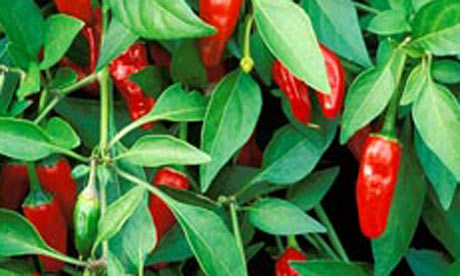
Indian style: Apache chillies are great for windowsills. Photograph: Jo Whitworth/Gap Photos
In a hellishly hot polytunnel in Bedfordshire, grower Joanna Plumb is laying to rest the myth that chillies are hard to grow. In fact, it pays to be a bit lax: "If you let them wilt and stress the plant out," she says. "It's one way of getting hotter chillies because the plant thinks it's going to die and puts all its energy into reproducing."
Plumb is an expert chilli grower and owner of Edible Ornamentals, growing thousands of chillies every year for everyone from supermarkets to Fortnum & Mason. She's convinced that these hot fruits are a great crop for the style of growing most of us can manage in modern life: chillies are perfectly content in a pot on a sunny windowsill or patio, with fruits that can be picked over a long period and easily stored for the following year.
It's too late to grow chillies from seed this year, but now's the perfect time to buy a couple of plants: if you pick the right variety, you should be harvesting until Christmas. The best ones for growing on windowsills and patios are compact and bushy, such as Apache and Prairie Fire: some of the bigger chillies can grow up to 2m. There are a few simple rules: put them in full sun, water little and often, and remember to feed. If you already have tomato feed, you can use it on chillies, though there is also a specially formulated feed called Chilli Focus. When roots start to show through the base of the container, switch the plant to a bigger pot using multipurpose compost.
Plumb says the most common moan from indoor growers is that their plants have dropped their flowers, but no fruits follow. There's an easy solution to this wrinkle, caused by the lack of insects for pollination: use a small paintbrush gently to rub the insides of the flowers and move pollen from bloom to bloom, mimicking an insect at work. If you have some outside space, the alternative is to give them some fresh air, but it's best to opt for pots rather than planting chillies in the ground. They need a minimum night-time temperature of 7C, so bring them inside in September and they should continue to fruit until December. You may even find you can enjoy a second harvest the following summer. Time outdoors also helps to defeat the chilli plant's main foe, the aphid: ladybirds will soon handle this pest if given the chance. Otherwise, keep a close eye on your indoor plants and gently rub off any aphid invaders with the tips of your fingers.
Hot harvest
Chillies will be ready to snip off from next month onwards, but there's no need to hang on until all the fruits are bright red. Harvest some while they are green and you'll encourage the plant to keep fruiting. While the UK is fixated with red chillies, in most countries chillies are picked when green. "A chilli when full size and green has maximum heat," Plumb say. "When it goes red, it is as hot, but it goes sweeter, like the difference between a green and a red sweet pepper."
Don't worry if your chillies turn black – this is simply part of the ripening process and the fruits will turn red in a few days. If you end up with more chillies than you can eat, freeze them whole, or purée them and freeze in an ice-cube tray; the thinner-walled varieties, such as Anaheim, are excellent dried – pick perfect fruits and use a darning needle to pierce the thick, green stem with fishing wire or strong thread and string them together. Hang them up in a sunny, airy spot (in front of a south-facing window, say). That way, you'll still be eating chillies when next summer's crop is about to ripen.



